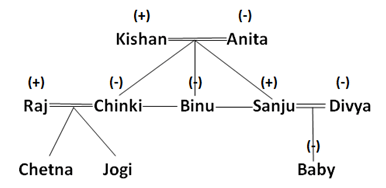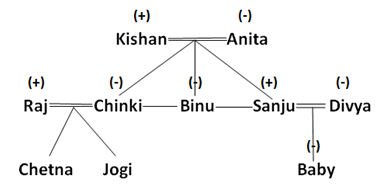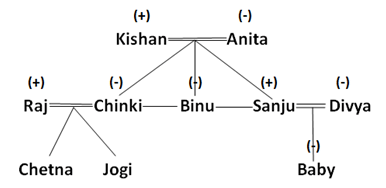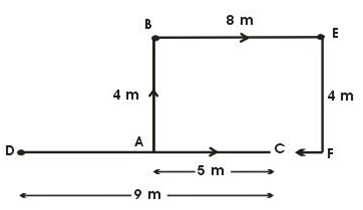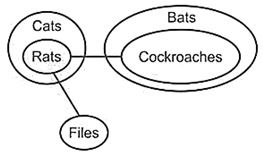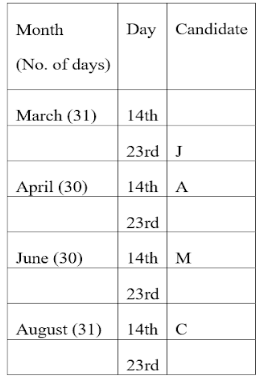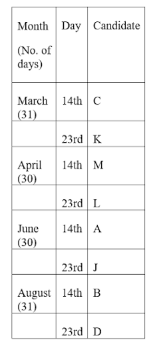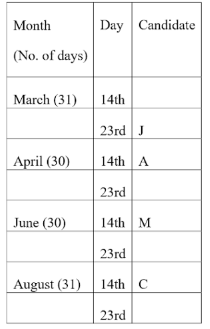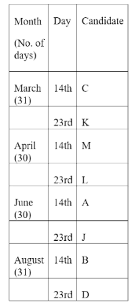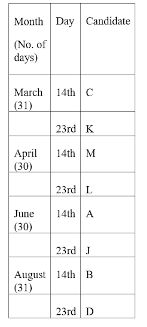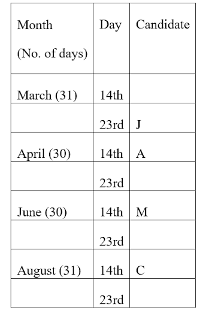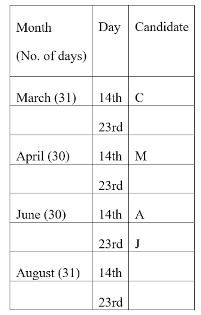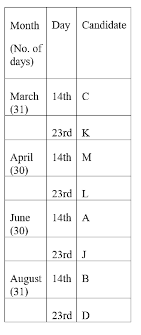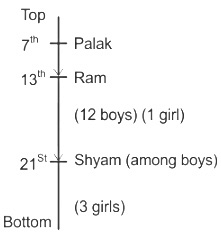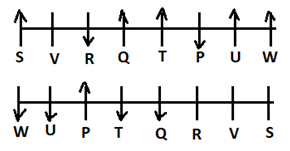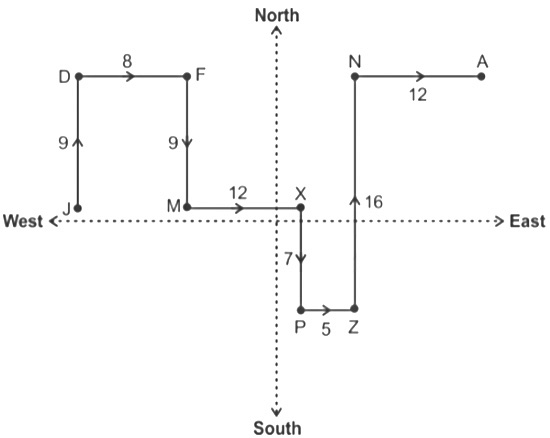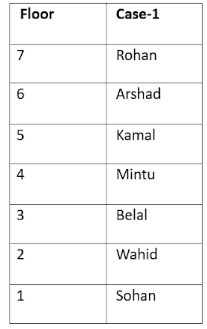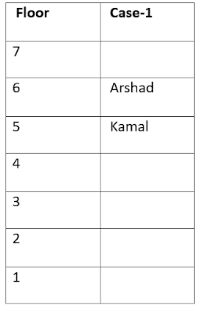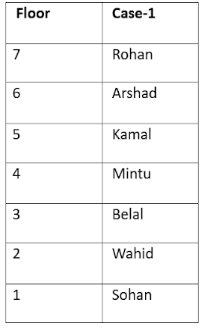IBPS RRB PO (Scale 1) Mains Mock Test - 8 - Bank Exams MCQ
30 Questions MCQ Test - IBPS RRB PO (Scale 1) Mains Mock Test - 8
Direction: Study the following information carefully and answer the questions given below. A number arrangement machine, when given a particular input, rearranges it following a particular rule. The following is the illustration of the input and the steps of arrangement.
Input: 11 456 34 768 987 56 67 345
Step I: 987 11 456 34 768 56 67 345
Step II: 987 11 768 456 34 56 67 345
Step III: 987 11 768 34 456 56 67 345
Step IV: 987 11 768 34 456 56 345 67
And Step IV is the last step of the rearrangement as the desired arrangement is obtained. As per the rules followed in the above steps, find out in each of the questions the appropriate step for the given input.
Input: 765 45 758 21 89 36 465 11
Q. Which of the following represents the sum of the first and the last elements in the third step?
Direction: Study the following information carefully and answer the questions given below. A number arrangement machine, when given a particular input, rearranges it following a particular rule. The following is the illustration of the input and the steps of arrangement.
Input: 11 456 34 768 987 56 67 345
Step I: 987 11 456 34 768 56 67 345
Step II: 987 11 768 456 34 56 67 345
Step III: 987 11 768 34 456 56 67 345
Step IV: 987 11 768 34 456 56 345 67
And Step IV is the last step of the rearrangement as the desired arrangement is obtained. As per the rules followed in the above steps, find out in each of the questions the appropriate step for the given input.
Input: 765 45 758 21 89 36 465 11
Q. Which of the following number is fifth from the left end of Step V in the above arrangement?
Direction: Study the following information carefully and answer the questions given below. A number arrangement machine, when given a particular input, rearranges it following a particular rule. The following is the illustration of the input and the steps of arrangement.
Input: 11 456 34 768 987 56 67 345
Step I: 987 11 456 34 768 56 67 345
Step II: 987 11 768 456 34 56 67 345
Step III: 987 11 768 34 456 56 67 345
Step IV: 987 11 768 34 456 56 345 67
And Step IV is the last step of the rearrangement as the desired arrangement is obtained. As per the rules followed in the above steps, find out in each of the questions the appropriate step for the given input.
Input: 765 45 758 21 89 36 465 11
Q. '765 11 758 45 21 89 36 465' is the which step of given input?
Direction: Study the following information carefully and answer the questions given below. A number arrangement machine, when given a particular input, rearranges it following a particular rule. The following is the illustration of the input and the steps of arrangement.
Input: 11 456 34 768 987 56 67 345
Step I: 987 11 456 34 768 56 67 345
Step II: 987 11 768 456 34 56 67 345
Step III: 987 11 768 34 456 56 67 345
Step IV: 987 11 768 34 456 56 345 67
And Step IV is the last step of the rearrangement as the desired arrangement is obtained. As per the rules followed in the above steps, find out in each of the questions the appropriate step for the given input.
Input: 765 45 758 21 89 36 465 11
Q. How many steps are needed to complete this arrangement?
Read the following information carefully and answer the question given below-
A family of ten members over three generation goes to a picnic. Kishan is the father of Binu and has only one son. Raj is the son-in-law of Anita and the father of Jogi. Sanju is the uncle of Chetna. Chinki is the aunt of Baby, who is the daughter of Divya. Divya is the daughter-in-law of Kishan. Anita is the mother of Chinki who has two children. Chinki and Binu are siblings. Each child has both of its parents alive.
Q. How many married couples are there in the family?
Read the following information carefully and answer the question given below-
A family of ten members over three generation goes to a picnic. Kishan is the father of Binu and has only one son. Raj is the son-in-law of Anita and the father of Jogi. Sanju is the uncle of Chetna. Chinki is the aunt of Baby, who is the daughter of Divya. Divya is the daughter-in-law of Kishan. Anita is the mother of Chinki who has two children. Chinki and Binu are siblings. Each child has both of its parents alive.
Q. How is Jogi related to Anita?
Read the following information carefully and answer the question given below-
A family of ten members over three generation goes to a picnic. Kishan is the father of Binu and has only one son. Raj is the son-in-law of Anita and the father of Jogi. Sanju is the uncle of Chetna. Chinki is the aunt of Baby, who is the daughter of Divya. Divya is the daughter-in-law of Kishan. Anita is the mother of Chinki who has two children. Chinki and Binu are siblings. Each child has both of its parents alive.
Q. How many male members are there in the family?
Read the following information carefully and answer the question given below-
A family of ten members over three generation goes to a picnic. Kishan is the father of Binu and has only one son. Raj is the son-in-law of Anita and the father of Jogi. Sanju is the uncle of Chetna. Chinki is the aunt of Baby, who is the daughter of Divya. Divya is the daughter-in-law of Kishan. Anita is the mother of Chinki who has two children. Chinki and Binu are siblings. Each child has both of its parents alive.
Q. Four of the following five are alike in the certain way and so form a group. Which is the one that does not belong to the group?
Direction: Study the following information to answer the given questions:
A man starts walking from point J, he walks 9 m in the north direction and reached at point D, after that he takes right turn and walks 8 m to reach at point F. From the point F, he takes right turn and walks 9 m to reach at point M and he takes left turn and walks 12 m to reach at point X. After that he takes right turn and walks 7 m to reach at point P and then he takes left turn and walks 5 m to reach at point Z and he takes another left turn and walks 16 m to reach at point N. Finally he takes right turn and walks 12 m to reach at point A.
Q. What is the shortest distance between A and Z?
Read the following statement carefully and answer the question given below.
Point B is 4 meters towards the North of point A.
Point E is 8 meters towards the East of point B.
Point C is 5 meters towards the East of point A.
Point D is 9 meters towards the West of point C.
Q. If a person walks 4 m South from the point E and then walks after taking a right turn, which of the following points would he reach first?
Direction: In the question below are given four statements followed by four conclusions numbered I, II, III and IV. You have to take the given statements to be true even if they seem to be at variance with commonly known facts. Read all the conclusions and then decide which of the given conclusions logically follows from the given statements disregarding commonly known facts.
Statements:
No rats are Cockroaches
No flies are Rats
All Cockroaches are Bats
All Rats are Cats
Conclusions:
I. All Bats are Flies
II. No Cats are Flies
III. Some Flies are Cats
IV. Some Cats are Bats
Each of the following questions consists of a statement followed by two arguments I and II.
Give answer:
(A) If only argument I is strong
(B) If only argument II is strong
(C) If either I or II is strong
(D) If neither I nor II is strong and
(E) If both I and II are strong.
Statement:
Should all the ongoing construction project banned in the city X?
Arguments:
I. Yes, due to these ongoing construction project the air pollution levels in city X are unacceptably high.
II. No, there are other factors to which contribute to the pollution of city X.
Directions: Study the following information carefully and answer the questions follows:
Seven people – A, C, E, P, R, T and U are sitting in a single row (not necessarily in the same order). Only three people are facing towards north and rest are facing south. Each of them likes different colours – Red, Blue, Green, Violet, Brown, Pink and White. The one who likes red is sitting fifth from the right end of the row. Only one person is sitting between R and the one who likes red. The one who likes green is sitting third to the left of R. The one who likes violet is an immediate neighbour of the one who likes green. A doesn’t like red but is sitting second to the right of the one who likes violet. U is an immediate neighbour of A and both are facing the opposite direction. The one who likes blue is sitting fourth to the left of U.E doesn’t like blue. The one who likes brown is sitting fourth to the left of E. E is sitting third to the right of C. P is sitting fourth to the right of the one who likes white.
Q. Who among the following is/are sitting at the extreme ends?
Directions: Study the following information carefully and answer the questions follows:
Seven people – A, C, E, P, R, T and U are sitting in a single row (not necessarily in the same order). Only three people are facing towards north and rest are facing south. Each of them likes different colours – Red, Blue, Green, Violet, Brown, Pink and White. The one who likes red is sitting fifth from the right end of the row. Only one person is sitting between R and the one who likes red. The one who likes green is sitting third to the left of R. The one who likes violet is an immediate neighbour of the one who likes green. A doesn’t like red but is sitting second to the right of the one who likes violet. U is an immediate neighbour of A and both are facing the opposite direction. The one who likes blue is sitting fourth to the left of U.E doesn’t like blue. The one who likes brown is sitting fourth to the left of E. E is sitting third to the right of C. P is sitting fourth to the right of the one who likes white.
Q. Who among the following likes Green?
Directions: Study the following information carefully and answer the questions follows:
Seven people – A, C, E, P, R, T and U are sitting in a single row (not necessarily in the same order). Only three people are facing towards north and rest are facing south. Each of them likes different colours – Red, Blue, Green, Violet, Brown, Pink and White. The one who likes red is sitting fifth from the right end of the row. Only one person is sitting between R and the one who likes red. The one who likes green is sitting third to the left of R. The one who likes violet is an immediate neighbour of the one who likes green. A doesn’t like red but is sitting second to the right of the one who likes violet. U is an immediate neighbour of A and both are facing the opposite direction. The one who likes blue is sitting fourth to the left of U.E doesn’t like blue. The one who likes brown is sitting fourth to the left of E. E is sitting third to the right of C. P is sitting fourth to the right of the one who likes white.
Q. Four of the following five options are alike in a certain way, find out the odd pair?
Directions: Study the following information carefully and answer the questions follows:
Seven people – A, C, E, P, R, T and U are sitting in a single row (not necessarily in the same order). Only three people are facing towards north and rest are facing south. Each of them likes different colours – Red, Blue, Green, Violet, Brown, Pink and White. The one who likes red is sitting fifth from the right end of the row. Only one person is sitting between R and the one who likes red. The one who likes green is sitting third to the left of R. The one who likes violet is an immediate neighbour of the one who likes green. A doesn’t like red but is sitting second to the right of the one who likes violet. U is an immediate neighbour of A and both are facing the opposite direction. The one who likes blue is sitting fourth to the left of U.E doesn’t like blue. The one who likes brown is sitting fourth to the left of E. E is sitting third to the right of C. P is sitting fourth to the right of the one who likes white.
Q. Who among the following is not facing towards south?
Read the following information carefully and answer the question given below-
Eight friends i.e. J, K, L, M, A, B, C and D are going for admission in a coaching institute in the different month of the same year viz. March, April, June and August. In each month, they are going coaching for the admission either on 14th or 23rd of the month. Not more than two candidates have been taken admission in the same month. A’s enrolled on 14th of the month which has only 30 days. Only three candidates have to enroll between A and C. J and C enrolled neither on the same day nor in the same month. J does not enroll in the month of April. Only two candidates have enrolled dates between J’s and M’s. B’ and M’s enroll dates are same but in different months. K has enrolled on one of the days before B enrolled. Only one person is enrolling between K and L. Less than four candidates have to enroll between L’s and D’s enroll dates.
Q. How many students enrolled between K and A?
Read the following information carefully and answer the question given below-
Eight friends i.e. J, K, L, M, A, B, C and D are going for admission in a coaching institute in the different month of the same year viz. March, April, June and August. In each month, they are going coaching for the admission either on 14th or 23rd of the month. Not more than two candidates have been taken admission in the same month. A’s enrolled on 14th of the month which has only 30 days. Only three candidates have to enroll between A and C. J and C enrolled neither on the same day nor in the same month. J does not enroll in the month of April. Only two candidates have enrolled dates between J’s and M’s. B’ and M’s enroll dates are same but in different months. K has enrolled on one of the days before B enrolled. Only one person is enrolling between K and L. Less than four candidates have to enroll between L’s and D’s enroll dates.
Q. Who among the following enrolled at last?
Read the following information carefully and answer the question given below-
Eight friends i.e. J, K, L, M, A, B, C and D are going for admission in a coaching institute in the different month of the same year viz. March, April, June and August. In each month, they are going coaching for the admission either on 14th or 23rd of the month. Not more than two candidates have been taken admission in the same month. A’s enrolled on 14th of the month which has only 30 days. Only three candidates have to enroll between A and C. J and C enrolled neither on the same day nor in the same month. J does not enroll in the month of April. Only two candidates have enrolled dates between J’s and M’s. B’ and M’s enroll dates are same but in different months. K has enrolled on one of the days before B enrolled. Only one person is enrolling between K and L. Less than four candidates have to enroll between L’s and D’s enroll dates.
Q. In which of the following day/month J enrolled?
Read the following information carefully and answer the question given below-
Eight friends i.e. J, K, L, M, A, B, C and D are going for admission in a coaching institute in the different month of the same year viz. March, April, June and August. In each month, they are going coaching for the admission either on 14th or 23rd of the month. Not more than two candidates have been taken admission in the same month. A’s enrolled on 14th of the month which has only 30 days. Only three candidates have to enroll between A and C. J and C enrolled neither on the same day nor in the same month. J does not enroll in the month of April. Only two candidates have enrolled dates between J’s and M’s. B’ and M’s enroll dates are same but in different months. K has enrolled on one of the days before B enrolled. Only one person is enrolling between K and L. Less than four candidates have to enroll between L’s and D’s enroll dates.
Q. How many students enrolled before A?
Direction: The question below consists of a question and three statements numbered I, II and III given below it. You have to decide whether the data provided in the statements are sufficient to answer the question.
There are 40 students in a class. The rank of Ram is 13th from the top. Palak, a girl is 7th from the top. There are 4 girls below the rank of Ram. There are 12 boys between Ram and another boy Shyam. Ram is a boy. How many girls are there in the class room?
Statement I: Shyam is 14th from the bottom among the students.
Statement II: There are 3 girls between Palak and Ram. Shyam is 21st from the top among the boys.
Statement III: Palak is 8th from the bottom among the girls.
In the question, One question is given followed by data in three statements 1, 2 and 3. You have to study the question and the data in statements and decide the question can be answered with data in which of the statements and mark your answer accordingly.
The conclusion: ‘All Apples are definitely not Mangoes” is true?
1. Some oranges are Apple. Some oranges are Yellow. All Mangoes are Yellow.
2. All oranges are Apple. Some Apples are Yellow. All oranges are Mangoes.
3. All Mangoes are Banana. All Apples are Guava. No Guava is Banana.
Direction: Study the following information carefully to answer the given question.
Eight persons viz. Anand, Aman, Abhinav, Atul, Anish, Ashish, Ankit and Abhishek played a match and scored different runs.
A#B means A always scored more than B.
A&B means A always scored less than B.
A@ means A scored highest runs.
A^ means A scored lowest runs.
A3$ means A scored third highest runs.
A3! means A scored third lowest runs.
A#*B means A has more runs than only B.
A&*B means A has less runs than only B.
A%B means A is not equal to B.
Further it is given that:
i) Aman &*1
ii) Anand #* (Atul, Ashish)
iii) Abhinav & Abhishek
iv) Ankit # Abhishek
v) Abhishek 4$
vi) Ankit # Anish
vi) The 2$ scored 80 runs.
Q. Who is A in A2!?
In the question, One question is given followed by data in three statements I, II and III. You have to study the question and the data in statements and decide the question can be answered with data in which of the statements and mark your answer accordingly.
Eight persons i.e. P, Q, R, S, T, U, V and W are sitting in a row in which some are facing north and some are facing south. Who amongst the following persons sits at the extreme ends of the row and facing which direction?
I. P sits third from one end of the row, Q second to the right of P and both face the opposite direction. Only one person U, who sits between P and W and face the same direction as Q face.
II. T and W faces the same direction as U is faces. R faces the same direction as P faces. S does not face north direction. R facing north and not an immediate neighbour of P. V sits immediate right of S.
III. S is third to the left of Q. Number of persons between Q and W is one more than between W and T. R is not neighbour of S. R and S faces the opposite direction. Immediate neighbour of R faces the opposite direction.
Direction: Study the following information to answer the given questions:
A man starts walking from point J, he walks 9 m in the north direction and reached at point D, after that he takes right turn and walks 8 m to reach at point F. From the point F, he takes right turn and walks 9 m to reach at point M and he takes left turn and walks 12 m to reach at point X. After that he takes right turn and walks 7 m to reach at point P and then he takes left turn and walks 5 m to reach at point Z and he takes another left turn and walks 16 m to reach at point N. Finally he takes right turn and walks 12 m to reach at point A.
Q. If a man walks 9 m towards the north from point X and he takes a left turn and walks for another 20 m, which of the following point would he reach?
Given below are a pair of events 'A' and 'B'. Read both the events 'A' and 'B' and decide their nature of relationship. Assume that the information given in 'A' and 'B' are true and don't assume anything beyond the given information in deciding the answer.
Events:
A. Romeo loved beauty and innocence.
B. Juliet was beautiful and innocent.
Direction: Study the following information and answer the given question.
In a seven-story building, having floors numbered one to seven, Kamal, Rohan, Sohan, Belal, Mintu, Wahid, and Arshad each live on a different floor. (The ground floor is numbered floor no. 1, the floor above it floor no. 2 and so on and the topmost floor is numbered 7.)
Kamal lives on the fifth floor. Arshad lives above the fifth floor and also live on an even number of floor. Only Belal lives between Mintu and Wahid. Mintu does not live on an odd-numbered floor. Mintu does not live on a floor immediately above or immediately below Sohan’s floor. Rohan does not live on the bottom-most floor.
Q. On which of the following floors does Sohan live?
Direction: Study the following information and answer the given question.
In a seven-story building, having floors numbered one to seven, Kamal, Rohan, Sohan, Belal, Mintu, Wahid, and Arshad each live on a different floor. (The ground floor is numbered floor no. 1, the floor above it floor no. 2 and so on and the topmost floor is numbered 7.)
Kamal lives on the fifth floor. Arshad lives above the fifth floor and also live on an even number of floor. Only Belal lives between Mintu and Wahid. Mintu does not live on an odd-numbered floor. Mintu does not live on a floor immediately above or immediately below Sohan’s floor. Rohan does not live on the bottom-most floor.
Q. Which of the following is correct?
Direction: Study the following information and answer the given question.
In a seven-story building, having floors numbered one to seven, Kamal, Rohan, Sohan, Belal, Mintu, Wahid, and Arshad each live on a different floor. (The ground floor is numbered floor no. 1, the floor above it floor no. 2 and so on and the topmost floor is numbered 7.)
Kamal lives on the fifth floor. Arshad lives above the fifth floor and also live on an even number of floor. Only Belal lives between Mintu and Wahid. Mintu does not live on an odd-numbered floor. Mintu does not live on a floor immediately above or immediately below Sohan’s floor. Rohan does not live on the bottom-most floor.
Who among the following lives on the top-most floor?
Direction: Study the following information and answer the given question.
In a seven-story building, having floors numbered one to seven, Kamal, Rohan, Sohan, Belal, Mintu, Wahid, and Arshad each live on a different floor. (The ground floor is numbered floor no. 1, the floor above it floor no. 2 and so on and the topmost floor is numbered 7.)
Kamal lives on the fifth floor. Arshad lives above the fifth floor and also live on an even number of floor. Only Belal lives between Mintu and Wahid. Mintu does not live on an odd-numbered floor. Mintu does not live on a floor immediately above or immediately below Sohan’s floor. Rohan does not live on the bottom-most floor.
Q. How many persons live between Kamal and Sohan?




